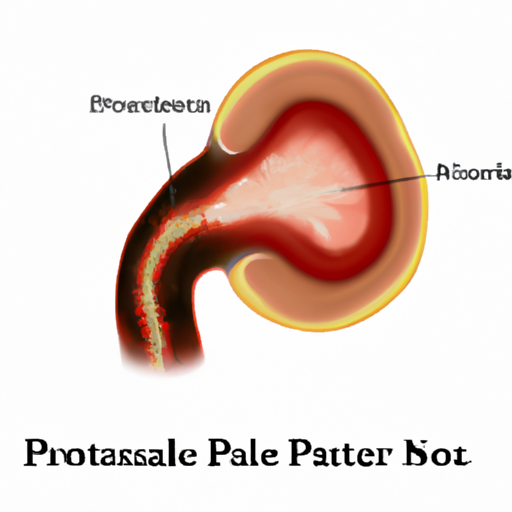Prostate inflammation, also known as prostatitis, is a common condition that affects many men worldwide. It is characterized by the inflammation and swelling of the prostate gland, which is a small walnut-shaped gland located below the bladder. Prostate inflammation can be caused by various factors, including bacterial infection, hormonal imbalances, or even certain lifestyle choices. While it is not a life-threatening condition, it can cause significant discomfort and impact a man's quality of life. In this article, we will explore the causes, symptoms, and risk factors associated with prostate inflammation. We will also discuss the key tests and screening methods used for diagnosis, as well as effective strategies and lifestyle recommendations for treating this condition. Whether you are currently experiencing symptoms or simply seeking to educate yourself on this topic, this article will provide you with a comprehensive understanding of prostate inflammation and how to manage it effectively.
1. Understanding Prostate Inflammation: Causes, Symptoms, and Risk Factors
Prostate inflammation, also known as prostatitis, is a common condition that affects many men worldwide. It refers to the inflammation or swelling of the prostate gland, which is a small walnut-sized gland located just below the bladder and in front of the rectum. Understanding the causes, symptoms, and risk factors associated with prostate inflammation is crucial for timely diagnosis and effective treatment.
There are several causes of prostate inflammation, and it can be classified into four main types: acute bacterial prostatitis, chronic bacterial prostatitis, chronic prostatitis/chronic pelvic pain syndrome (CP/CPPS), and asymptomatic inflammatory prostatitis. Acute bacterial prostatitis is caused by a bacterial infection, whereas chronic bacterial prostatitis is a recurrent infection that may be caused by bacteria residing in the prostate gland. CP/CPPS is the most common type, accounting for more than 90% of prostatitis cases, and its exact cause is unknown. Asymptomatic inflammatory prostatitis does not exhibit any symptoms and is usually detected incidentally during medical tests.
The symptoms of prostate inflammation can vary depending on the type and severity of the condition. Common symptoms include frequent urination, urgency to urinate, pain or discomfort in the pelvic area or genitals, difficult or painful urination, pain during ejaculation, and erectile dysfunction. Some individuals may also experience flu-like symptoms such as fever, chills, and body aches. However, it is important to note that some men with prostate inflammation may not experience any symptoms at all.
Various risk factors can increase the likelihood of developing prostate inflammation. These include a history of urinary tract infections, previous prostate infections, recent bladder infection, a weakened immune system, anatomical abnormalities of the urinary tract, and sexual activity. Additionally, certain lifestyle factors such as prolonged sitting, stress, and a poor
2. Diagnosing Prostate Inflammation: Key Tests and Screening Methods
Diagnosing Prostate Inflammation: Key Tests and Screening Methods
Prostate inflammation, also known as prostatitis, is a common condition that affects men of all ages. However, diagnosing prostate inflammation can be challenging as its symptoms often overlap with those of other prostate-related disorders. To accurately diagnose prostate inflammation, several key tests and screening methods are utilized. These diagnostic tools help healthcare professionals determine the presence and severity of the condition, allowing them to develop an appropriate treatment plan tailored to the patient's needs.
1. Medical History and Physical Examination:
The first step in diagnosing prostate inflammation involves taking a detailed medical history and performing a physical examination. During the medical history assessment, the healthcare provider will inquire about the patient's symptoms, duration, and any possible triggers. They will also ask about the patient's medical history, including any previous prostate-related conditions or surgeries. A comprehensive physical examination may include a digital rectal examination (DRE), where the healthcare provider inserts a lubricated, gloved finger into the rectum to feel the prostate gland for any abnormalities.
2. Urine Tests:
Urine tests are commonly used to diagnose prostate inflammation and rule out other urinary tract infections. A urine sample is collected and analyzed to identify the presence of bacteria or white blood cells that indicate inflammation. Urine samples may also be cultured to identify the specific bacteria responsible for the infection, allowing for targeted antibiotic treatment.
3. Blood Tests:
Blood tests are valuable in diagnosing prostate inflammation as they provide important information about the overall health of the patient and the presence of infection or inflammation. A complete blood count (CBC) is typically performed to assess the white blood cell count, which can indicate an ongoing infection. Additionally, a prostate-specific antigen (PSA) blood test may be conducted to measure the levels of a protein produced by the prostate gland. Elevated
3. Treating Prostate Inflammation: Effective Strategies and Lifestyle Recommendations
Treating Prostate Inflammation: Effective Strategies and Lifestyle Recommendations
When it comes to treating prostate inflammation, also known as prostatitis, it is vital to adopt a multifaceted approach that combines medical interventions with lifestyle modifications. The aim is to alleviate symptoms, reduce inflammation, and improve overall prostate health. Here are some effective strategies and lifestyle recommendations that can help in the treatment of prostate inflammation:
1. Antibiotics and Medications: Prostate inflammation can often be caused by bacterial infections, so the first line of treatment usually involves antibiotics. Your healthcare provider may prescribe a course of antibiotics to combat the underlying infection and reduce inflammation. It is essential to complete the full course of antibiotics as prescribed, even if symptoms improve, to ensure the infection is completely eradicated. In addition to antibiotics, nonsteroidal anti-inflammatory drugs (NSAIDs) or alpha-blockers may be recommended to manage pain and discomfort associated with prostatitis.
2. Physical Therapy and Prostate Massage: In some cases, physical therapy techniques such as pelvic floor muscle exercises, biofeedback, and prostate massage may be prescribed. These techniques can help relax the muscles around the prostate, improve blood flow, and reduce inflammation. Prostate massage can also help with the drainage of accumulated prostatic fluid, relieving symptoms and promoting healing.
3. Lifestyle Modifications: Making certain lifestyle changes can significantly contribute to the treatment of prostate inflammation. Here are some recommendations:
a. Fluid Intake: Staying well-hydrated is crucial for maintaining prostate health. Drinking an adequate amount of water helps flush out toxins and bacteria, reducing the risk of infection.
b. Diet: A balanced and nutritious diet plays a vital role in managing prostate inflammation. Including foods rich in antioxidants, such as fruits, vegetables, whole grains, and healthy fats, can help reduce inflammation. Avoiding

